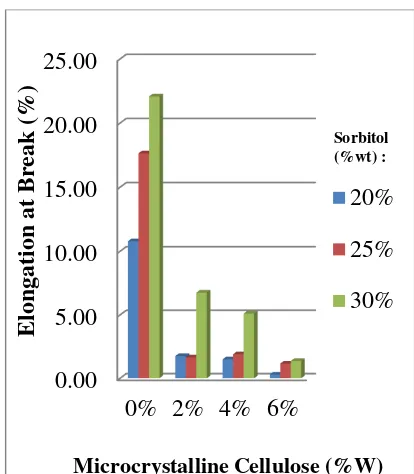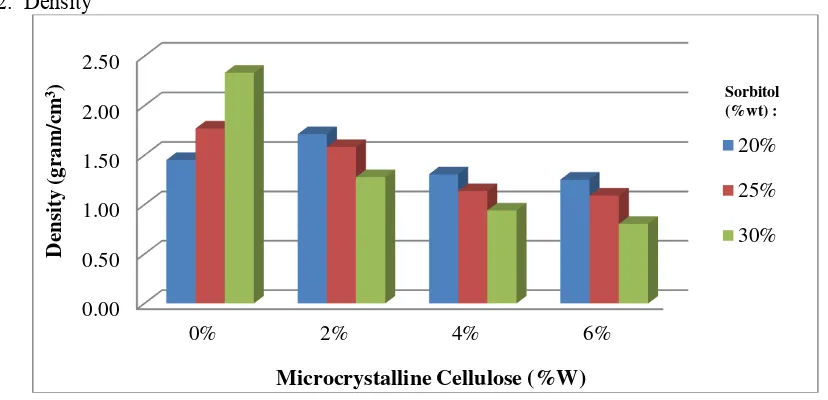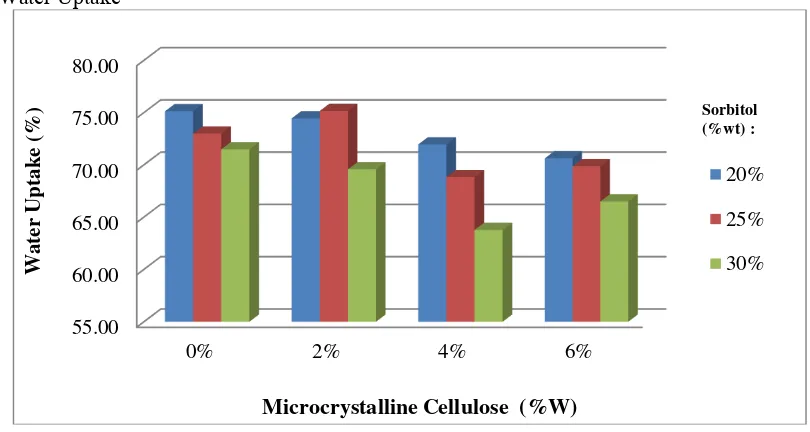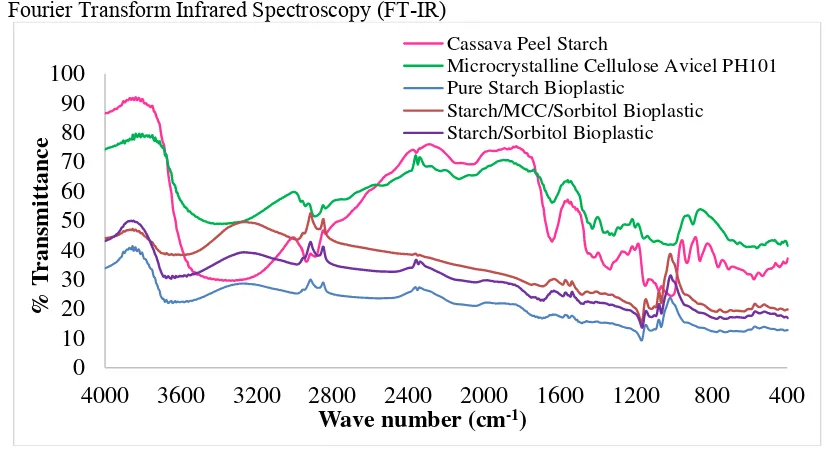Journal of Physics: Conference Series
PAPER • OPEN ACCESS
Production of Starch Based Bioplastic from
Cassava Peel Reinforced with Microcrystalline
Celllulose Avicel PH101 Using Sorbitol as
Plasticizer
To cite this article: Maulida et al 2016 J. Phys.: Conf. Ser. 710 012012
View the article online for updates and enhancements.
Related content
Improvement of toughness and water resistance of bioplastic based on wheat gluten using epoxidized natural rubber S Hemsri, C Thongpin, P Somkid et al.
-Preparation and Characterization of Cellulose and Nanocellulose from Agro-industrial Waste - Cassava Peel S Widiarto, S D Yuwono, A Rochliadi et al.
-Bioplastic production from cellulose of oil palm empty fruit bunch
Isroi, A Cifriadi, T Panji et al.
-Recent citations
Effect of Ultrasonic Treatment on Morphology and Mechanical Properties of Bioplastic from Cassava Starch with Nanoclay Reinforcement
Nanang Eko Wahyuningtiyas and Heru Suryanto
Production of Starch Based Bioplastic from Cassava Peel
Reinforced with Microcrystalline Celllulose Avicel PH101
Using Sorbitol as Plasticizer
Maulida1, M Siagian1, P Tarigan1
1Department of Chemical Engineering, University of North Sumatera, Medan,
Indonesia
E-mail: [email protected]
Abstract. The production of starch based bioplastics from cassava peel reeinforced with microcrystalline cellulose using sorbitol as plasticizer were investigated. Physical properties of bioplastics were determined by density, water uptake, tensile strength and Fourier Transform Infrared Spectroscopy. Bioplastics were prepared from cassava peel starch plasticized using sorbitol with variation of 20; 25; 30% (wt/v of sorbitol to starch) reinforced with microcrystalline celllulose (MCC) Avicel PH101fillers with range of 0 to 6% (wt/wt of MCC to starch). The results showed improvement in tensile strength with higher MCC content up to 9,12 mpa compared to non-reinforced bioplastics. This could be mainly attributed to the strong hydrogen bonds between MCC and starch. On the contrary, the addition of MCC decreased the elongation at break, density and water uptake. Fourier Transform Infrared Spectroscopy showed the functional groups of bioplastics, which the majority of O-H groups were found at the bioplastics with reinforcing filler MCC that represented substantial hydrogen bonds. The highest tensile strength value was obtained for bioplastic with MCC content 6% and sorbitol content 20%. With good adhesion between MCC and starch, the production of bioplastics could be widely used as a substitute for conventional plastics with more benefits to the environment.
1. Introduction
Packaging plays a significant part in recent years as over 67 millions tonnes of packaging waste resulting in environmental concerns. This provokes many different processing, for example the using of additives such as fillers, colourants and plasticizers to produce polymers as packaging applications [1]. Environmental, economic and safety challenges have caused many scientists to invent biodegradable polymers as a substitute for petrochemical based polymers. This biodegradable polymers or bioplastics indicate more eco-friendly environment than the conventional plastics which lead to environmental issues [2]. But there is still a lack in the development of bioplastics as its high cost of production leads to certain limitations. An alternative for a low cost and renewable substrate has been proposed by using agriculture waste (AW) [3]. In addition to performance and abundant sources, starch from agriculture waste is the solution for an alternative. Starch as biodegradable polymer becomes reasonable material for the production of bioplastics beacause of its low cost [4]. Therefore, production of bioplastics is the breakthrough innovation to solve the environmental issues by using renewable and degradable natural resources and to provide more cost effective bioplastics.
ScieTech 2016 IOP Publishing
Raw materials for bioplastics originate from natural constituents such as polysaccharides (e.g. starch, cellulose, chitin and lignin), proteins (e.g. gelatine, casein and wheat gluten) and lipids (e.g. plant oils and animals fats) [1]. In Indonesia, development of starch based bioplastics has a big potential, because starch can be easily obtained by majority of Indonesia’s plants. One of the most abundant source for starch production in Indonesia is from cassava. Cassava processing results in organic waste such as cassava peel that can be used as bioplastic matrix for its high starch content. However, bioplastic based on starch still has many disadvantages like poor mechanical properties and high moisture adsorption, therefore an alternative is used to improve its properties [5]. Reinforcing fillers such as cellulose has proven to be the most promising material. Microcrystalline cellulose used as reinforcement filler for starch based edible films was analyzed by Psomiadou et al. (1996). The results showed higher strength and elongation and lower water vapour transmission rate (WVTR) of bioplastics. Microcrystalline cellulose Avicel PH 101 is used as reinforcing filler because it offers higher density of hydroxyl groups on its surface that is available for hydrogen bonding [5].
Utilization of organic waste such as cassava peel for production of starch based bioplastic can help reducing the environmental damages that are caused by conventional plastics. Higher value bioplastics can be obtained by improving their properties with the most abundant and biodegradable reinforcing filler like cellulose. The goal of this work is to study the properties of bioplastics from agriculture waste. Effect of reinforcement fillers and plasticizers on bioplastics are also examined.
2. Materials and Methods
2.1. Materials
Starch derived from cassava peel was obtained from Traditional Market Medan, microcrystalline cellulose (MCC) Avicel PH101 was obtained from Pusat Penelitian Kelapa Sawit Medan with particle size 50 µm, and sorbitol 99% was obtained from Rudang Jaya Medan.
2.2. Preparation of Cassava Peel Starch
Cassava peel (100 gram) obtained from waste container at local traditional market was washed with clean water before shredded to small pieces. The shredded cassava peel was later peeled and placed in mixing blender and soaked in water for about 100 ml. After mixing process, starch slurry was filtered and later placed in tank for settling that took at least 30 minutes. Starch sediment was separated from the slurry and then washed again with distilled water. After the second settling, starch sediment was dried using oven with temperature 70 oC for removal of free water. Starch was sieved with strainer 100
mesh/inch for better homogeneous size.
2.3. Bioplastic Preparation
Solution containing 0, 2, 4 and 6% wt/wt of fillers to starch was prepared by dispersing 200 ml distilled water and sorbitol with concentration varied from 20, 25 and 30% wt/v of plasticizer to starch. Solution was placed into ultrasonic homogenizer KUDOS tank and processed for about 50 minutes. After ultrasonication, solution was removed from the tank. Starch (10 gram) was added to the solution and heated using hot plate while stirred until it gelatinized (70 oC). After mixing, the solution
was cast onto flat and dried with temperature 60 oC for 24 hour. Once set, bioplastic was cooled to
ambient temperature before peeled off the flat.
2.4. Bioplastic Characterizations
2.4.1. Tensile Strength and Elongation at Break. Tensile strength was measured with GoTech Universal Testing Machine using the standard of ASTM D882-91. Tensile strength value was obtained from the observed data. Elongation at break is an indication of bioplastics flexibility and is expressed as a percentage. Elongation at break was calculated as follows :
ScieTech 2016 IOP Publishing
Journal of Physics: Conference Series710(2016) 012012 doi:10.1088/1742-6596/710/1/012012
Elongation at break (ɛ) = extension x 100
gauge (1)
2.4.2. Density. Density of bioplastic was investigated by the standard of ASTM D792-91 on film with size approximately 5x5 cm. The film’s mass was measured using analytical balance. Density was calculated as follows :
Density = mass (gr)
volume (cm3) (2)
2.4.3. Water Uptake. Water uptake was investigated by cutting film with size approximately 2x2 cm and then weighed the mass. Film was put into a container filled with distilled water for 24 hour. After immersion in water, film was removed from the water and weighed to measure the wet weight. Water uptake was calculated as follows :
Water uptake = wet weight−dry weight
wet weight x 100% (3)
2.4.4. Fourier Transform Infrared Spectroscopy (FT-IR). Functional groups of bioplastics were analyzed by using IR Prestige-21 Shimadzu. The analysis using FT-IR represented spectrum data in graphic and wave numbers of each data that provided functional groups of bioplastics.
3. Results
3.1. Tensile Strength and Elongation at Break
Figure 1. Tensile strength of starch based bioplastic reinforced with MCC Avicel PH101 using sorbitol as plasticizer.
Figure 2. Elongation at break of starch based bioplastic reinforced with MCC Avicel PH101 using sorbitol as plasticizer.
Figure 1 shows the results of tensile strength and elongation at break as a function of MCC content for plasticized starch based bioplastic. It indicated that tensile strength increased with the increasing of MCC content. Results showed an increase of tensile strength from 0 to 6% MCC content for bioplastics with 20 and 30% sorbitol. The improvement of bioplastic properties can be attributed to good interfacial adhesion that can form strong 3D hydrogen bond network that is occured between starch matrix and MCC fillers [5]. Thus, bioplastic with MCC content 6% and 20% sorbitol provided the maximum tensile strength for 9,12 MPa. A drop in tensile strength value is shown for bioplastic
0.00
with MCC content 4% and sorbitol content 25%. It is possibly due to higher content of MCC contributed to retarding the intermolecular interaction thus resulting in aggregates and heterogeneous film structure [5]. Plasticizer is necessary for production of bioplastics to increase its flexibility and workability, on the other hand addition of plasticizer results in lower hardness [8]. Thus higher sorbitol content resulted in lower tensile strength. It should be noted that increasing the sorbitol content up to 30% resulted in lower tensile strength. However, for bioplastics with sorbitol content below 30%, a primary concern that there is sometimes not enough plasticizing effect and starch molecules become brittle [9]. This could be seen on bioplastics with MCC content 2 and 4% for 25% sorbitol.
Contrary to tensile strength value, figure 2 shows the results of elongation at break as the addition of MCC content decreased the value. Results showed a decrease in elongation at break with the increasing MCC content from 0 to 6%. It is possibly due to hydrogen bond [5] between hydroxyl group (O-H) from starch and hydroxyl and carboxyl group (COOH) of cellulose. This bonding resulted in a higher strength and lowered the elongation at break. Meanwhile, addition of plasticizers to bioplastics have the opposite effect on elongation at break. Plasticizers give elastic properties to plastic and have the ability to weaken the intermolecular hydrogen bond and increase spacing [10]. An increase in elongation at break with higher sorbitol content was linked to the addition of plasticizers that act as the compatibilizer to improve the interaction between matrix and fillers. However, bioplastic with MCC content 2% and 25% sorbitol provided an increase in elongation at break. This could be attributed to an antiplasticisation effect. Myllarinen et al. (2002) reported that film with sorbitol content below 27% has the tendency to strong interaction between starch and sorbitol which resulted in decreasing mobility of system. Antiplasticisation effect also results in rigid and brittle plastic. The highest elongation at break value was observed at bioplastic with MCC content 0% and 30% sorbitol.
Base on the values obtained in figure 1 and figure 2, the results show the relationship between the addition of reinforcement fillers and plasticizers to the mechanical propeties of bioplastics. While the addition of MCC as reinforcement fillers represented an improvement in tensile strength with increasing value, elongation at break showed otherwise. This indicates that MCC is used to strengthen materials but results in more brittle plastics. On the other hand, plasticizers improved the brittleness
by increasing sorbitol’s content but resulted in lower tensile strength.
3.2. Density
Figure 3. Density of starch based bioplastic reinforced with MCC Avicel PH101 using sorbitol as plasticizer.
The effect of MCC content on density of plasticized starch based bioplastic is shown in Figure 3. Density increased for bioplastics with 0% MCC, on the other hand density of bioplastics decreased as
0.00
Journal of Physics: Conference Series710(2016) 012012 doi:10.1088/1742-6596/710/1/012012
the content of MCC increased from 2 to 6%. Bierley et al. (1988) conveyed that plastics with lower density tended to have open structure which can be penetrated by fluids, such as H2O, O2 or CO2. The
results showed that addition of MCC trigerring in lower density. This could be attributed to decrease in crystallinity index of MCC after ultrasonic treatment as reported by Zhang et al. (2013). Decrease in crystallinity leads to an increase in amorphous fraction. Higher amorphous fraction attributes to lower
polymer’s mass because of the un-uniformity and less dense molecules that results in lower density. Plasticizers also effect the density of bioplastics as increasing plasticizers content causes network to swell and results in the decrease of network density [14]. The highest density value was found at bioplastic without reinforcing MCC and 30% sorbitol content.
3.3. Water Uptake
Figure 4. Water uptake of starch based bioplastic reinforced with MCC Avicel PH101 using sorbitol as plasticizer.
The effect of MCC content on water uptake of plasticized starch based bioplastic is shown in Figure 4. Water uptake decreased as the content of MCC increased for bioplastics with MCC content 0, 4 and 6%. Furthermore, starch was more sensitive to water because of its hydrophilic nature than cellulose [15]. On the other hand, an increase in water uptake was found for bioplastic with MCC content 2% and 25% sorbitol. Cellulose has strong hydrogen bond and characteristic that has the difficulty to bond with water. However, the excess addition of cellulose has the capability to increase water absorption because the intramolecular hydrogen bonding. An increase in water uptake could not fully homogeneous and resulted incorporated particles. This could be attributed to the less handled ultrasonication process.
55.00 60.00 65.00 70.00 75.00 80.00
0% 2% 4% 6%
Wat
er
U
ptak
e (
%)
Microcrystalline Cellulose (%W)
20%
25%
30%
Sorbitol (%wt) :
ScieTech 2016 IOP Publishing
3.4. Fourier Transform Infrared Spectroscopy (FT-IR)
Figure 5. FTIR specs of cassava peel starch, MCC, pure starch bioplastic, strach/MCC/sorbitol bioplastic and starch/sorbitol bioplastic
The analysis of FT-IR shows the characteristic peaks from bioplastics. FT-IR is used for its indirect analytical method to study molecular structures [16] and has the capability to measured functional groups in greater speed and greater sensitivity [17]. The interaction between bioplastic’s components
can be identified from FT-IR spectra. If components form immiscible blends, then no appreciable changes can be found in FT-IR spectra. However, if the components are compatible, chemical interaction exists between their chains culminating in the change of FT-IR spectra [18]. Figure 5 shows the results of characteristic peaks of cassava peel starch, MCC, pure starch bioplastic, starch/MCC/sorbitol bioplastic and starch/sorbitol bioplastics. The rose colored line represented characteristic peaks for cassava peel starch. It could be observed that the hydrogen bond –OH stretching at 2835 cm-1 and the C-H stretching at 709 cm-1. Characteristic peak at 1242 cm-1 indicated
C-O bending of C-O-H group [9]. The green colored line represented characteristic peaks for MCC with –OH bending at 3383 cm-1. The peaks at 1002 cm-1, 1103 cm-1 and 1157 cm-1 were attributed to
C-O stretching. The bending peak of C=C bond appeared at 1639 cm-1. The blue colored line
represented pure starch bioplastic’s characteristic peaks. For –OH stretching and bonding appeared at 2877 cm-1 and 3649 cm-1 repectively. Characteristic peaks at 1111 cm-1 and 1176 cm-1 indicated C-O
strecthing. The maroon colored line represented starch/MCC/sorbitol bioplastic’s characteristic peaks. It could be observed that the C-O stretching at 1064 cm-1, 1118 cm-1 and 1168 cm-1. The peaks at 2870
cm-1 and 2989 cm-1 indicated –OH stretching while peak at 3633 cm-1 indicated –OH bonding. The
purple colored line represented starch/sorbitol bioplastic’s characteristic peaks. For –OH stretching and bonding appeared at 2877 cm-1 and 3668 cm-1 repectively. The peaks at 1107 cm-1 and 1172 cm-1
indicated C-O stretching.
The addition of MCC and sorbitol aims to modify starch matrix. Lower wave number results in stronger hydrogen bond [9] as C-O peak of starch/MCC/sorbitol bioplastic is wider than the pure starch bioplastic. This means that the strong hydrogen bonding exist between C-O of starch and –OH of MCC. Furthermore, the addition of sorbitol can improve the intermolecular interaction.
4. Conclusion
The cassava peel starch/MCC bioplastics increased in tensile strength from 0,88 MPa for pure starch bioplastic to 9,12 MPa. Contrary to tensile strength, a decrease in elongation at break was reported. The improvement in bioplastics with reinforcing MCC could be attributed to the strong hydrogen bond between hydroxyl groups of the interface of both MCC fillers and starch matrix. This formation is also
0
Journal of Physics: Conference Series710(2016) 012012 doi:10.1088/1742-6596/710/1/012012
influenced by the percolation mechanism. Density of bioplastics decreased as MCC content increased. Furthermore, addition of MCC content decreased water uptake of bioplastics. The incorporation of MCC particles into starch matrix resulted in agglomerates that caused deflections in bioplastics. FT-IR spectra provided information about hydrogen bond through its characteristic peak. Bioplastic with the highest tensile strentgh assumed to have better characteristics than the other bioplastic was found at MCC content 6% and 20% sorbitol.
References
[1] Song J H, Murphy R J, Narayan R, Davies G B H 2009 Biodegradable and compostable alternatives to conventional plastics. Phil. Trans. R. Soc. B364 2127–2139
[2] Reddy L, Reddy S, Gupta A 2013 Study of bio-plastics as green and sustainable alternative to plastics IJETAE3 76–81
[3] Jain R, Tiwari A 2015 Biosynthesis of planet friendly bioplastics using renewable carbon source
J Environ Health Sci Eng13
[4] Mose B R, Maranga S M 2011 A review on starch based nanocomposites for bioplastic materials J Mat Sci Eng 1 239-245
[5] Wittaya T 2009 Microcomposites of rice starch film reinforced with microcrystalline cellulose from palm pressed fiber. Int. Food. Res. J16 493–500
[6] Psomiadou E, Arvanitoyannis I, Yamamoto N 1997 Edible films made from natural resources; microcrystalline cellulose (MCC), methylcellulose (MC) and corn starch and polyols. Part 2.
Carbohydr Polym31 193–204
[7] Jonat S, Albers P, Gray A, Schmidt P C 2006 Investigation of the glidant properties of compacted colloidal silicon dioxide by angle of repose and X-ray photoelectron spectroscopy Eur J Pharm Biopharm. 63 356–9
[8] Vieira M G A, Silva M A D, Santos L O D Beppu M M 2011 Natural-based plasticizers and biopolymer films: A review Eur. Polym. J.47 254-263
[9] Ahmad Z, Anuar H, Yusof Y 2011 The Study of Biodegradable Thermoplastics Sago Starch
Key Engineering Materials 471-472 397-402
[10] Cao N, Yang X, Fu Y 2009 Food Hydrocolloids23 729–735
[11] Myllarinen P, Partanen R, Seppala J, Forssell P 2002 Effect of glycerol on behaviour of amylose and amylopectin films Carbohydr Polym.50 355-361
[12] Bierley A W, Heat R J, Scott M J 1988 Plastic Materials Properties and Aplications (New York : Chapman and Hall Publishing)
[13] Zhang Q, Benoit M, Vigier K D O, Barrault J, Jégou G, Philippe M, Jérôme F 2013 Pretreatment of microcrystalline cellulose by ultrasounds: effect of particle size in the heterogeneously-catalyzed hydrolysis of cellulose to glucose Green Chem.15 963–969 [14] Wypych G 2004 Handbook of Plasticizer (Toronto : ChemTec Publishing)
[15] Dufresne A, Vignon M R 1998 Macromolecules31 2693-2696
[16] Porras M A, Cubitto M A, Villar M A 2015 A new way of quantifying the production of poly(hydroxyalkanoate)s using FTIRJ Chem Tech Biotechnol
[17] Pavia D L, Lampman G M, Kriz G S 2001 Introduction to Spectroscopy (Philadelphia : Thomson Brooks/Cole) p 23
[18] Qu P, Gao Y, Wu G F, Zhang L P 2010 BioResouces5 1811-1823
ScieTech 2016 IOP Publishing



